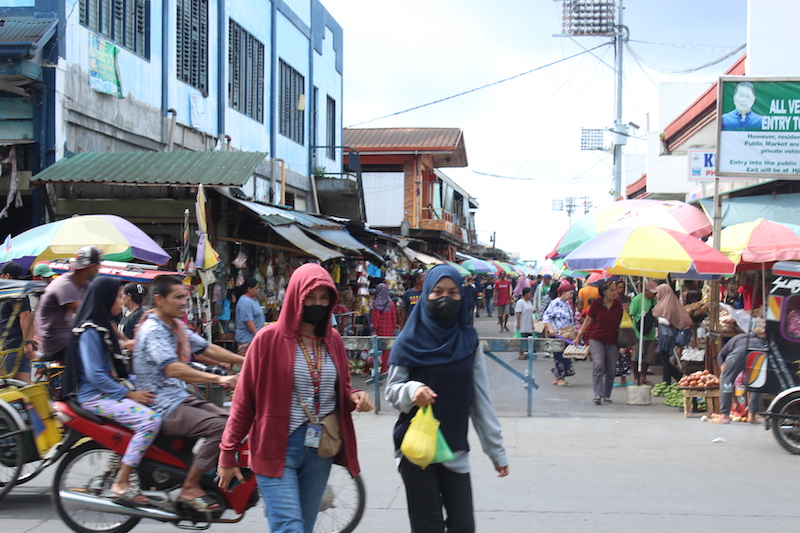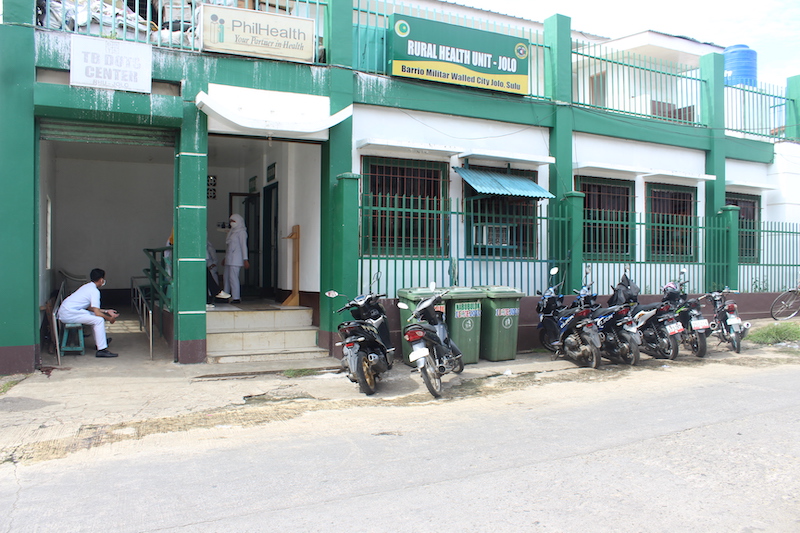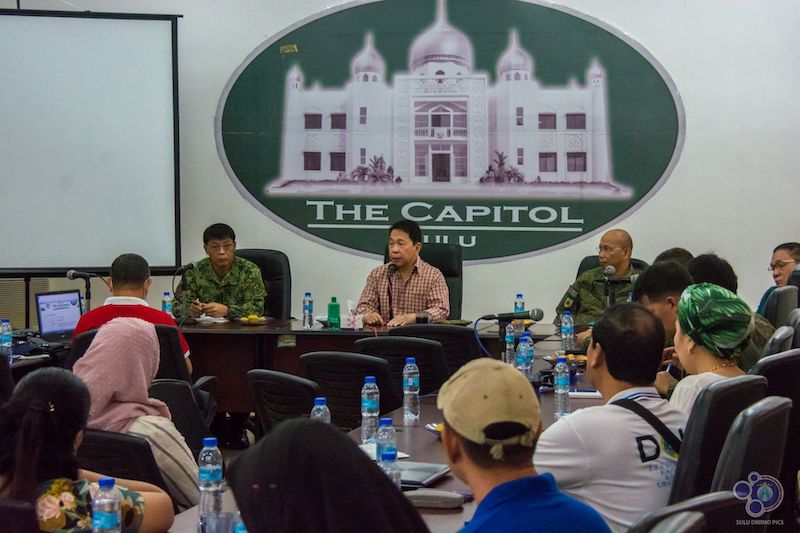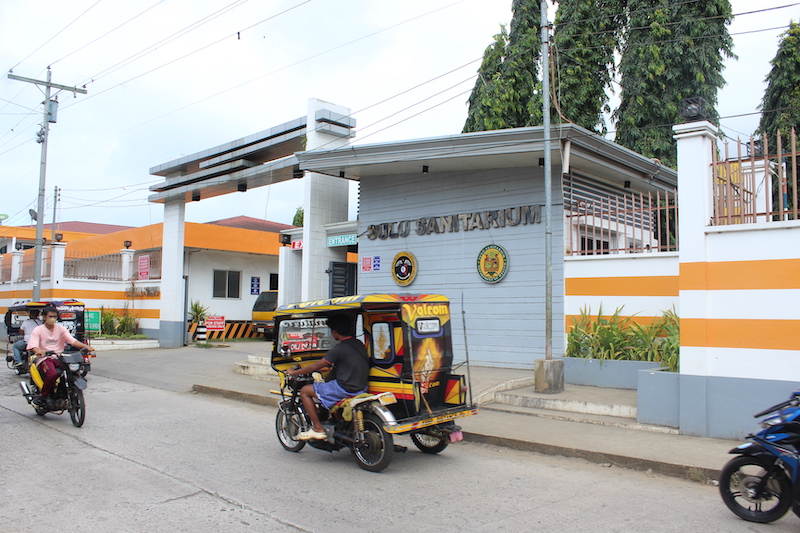Posted to MindaNews (Mar 28, 2023): Sulu and the Outbreak: Hostility, Hospitality, Hospital (By MUCHA-SHIM L. QUILING)
JOLO, Sulu (MindaNews / 28 March) — The road to new normal Sulu is paved with ringing laughter and banter of giggly pre-teen boys in bright colored oversized jerseys of vermillion yellow and turquoise blue on whose breasts are announced in bold letters the hometowns they hail from, the pride-word “Batah Sug” at heart and gleaming in their eyes.
This, not the post-script anxiety and uncertainty of a pandemia portending to extend its hospitality, surely makes for a better story to tell about the new normal. Of youth and children – of life itself – having come out of isolation of dread and released from the quarantine of fears are now a gleeful image of celebration of freedom.
After almost three years incommunicado, they once again gathered in the moist and fertile grassfields of Sulu Capitol grounds in Bangkal, Patikul, the same grassfield growing out of the volcanic soil of 650 years past has always seemed to have the propensity to keep growing and thriving despite proverbial elephantian politics trampling it and games of powers killing lives and hopes.
The youth representing chosen municipalities in Sulu province recently converged in mainland Jolo as delegates for a football draft in a try-out that was kick-started by Hadji Abdusakur Mahail Tan, the Governor of Sulu, the benefactor himself. In fact, the year 2023 opened with exultant high-spirit in Sulu with a welcome basketball match from all provinces of the Bangsamoro Autonomous Region in Muslim Mindanao (BARMM).

Downtown Jolo in Sulu.
From sunrise to sundown, jampacked crowd trooped to new Maimbung gym eager to watch teams of cagers competing in an invitational tournament hosted by the Vice Governor Abdusakur A. Tan II fondly called by the diminutive Totoh, of his provenance was also followed later with the Tausug hosting of foreign Muslim religious missionaries coming to Zamboanga City to lecture in “Smile is Charity.”
The town of Jolo celebrated its 119th Anniversary of Local Governance in February with aplomb. By all accounts, events and activities be it governmental, educational, cultural, sports, or of arts and entertainment were always fully-attended and their aftermath filled the coffeeshops and buzzed among market vendors for days.
Meanwhile, everyday new picturesque places of natural beauties are being spotted by locals who as though for the first time have begun discovering and seeing touristic Sulu for the first time. Over the weekend, trekkers and bikers excitedly trooped to their more recent find in yet another untrodden isuk gimba (wilds) of Panglima Estino of mountain spurts called Badjang Falls, comparably as majestic and much taller than the instagrammable most-selfied cascading waters of Tambuwang in Maimbung. And just as exhilarating, a drone hovers over Omar, a municipality carved out of Luuk Empire – of Maas Kamlun fame – whisking wild the blandest of all imaginations into an eagle’s flight to bask over the beautiful and the adventurous over ruggedness of crags and promontories contrasting the languidness of its powdery white beaches and coolest blue of seas.
Where the strings of blinking neon lights compete with solar-powered streetlamps for the prestige of wrapping the length of Umangay seafront in Patikul as the neatly paved boulevard and coastways keep getting longer by the day and brighter by the night, it makes it even harder indeed to reckon and write about Sulu in dark tones any more than it is to murmur murderous thoughts to knead and reshape dread and uncertainty anew in stories of either war or virus.

Rural Health Unit in Jolo, Sulu.
Digging up Facebook and social media and the usual places for grief-peddlers are no help at all, the virtual repository of human emotions and marketplace of travails proved uninspiring in this useless window shopping for empty desperation because the Sulu millennials of today have seemed mostly turned into helpless happy blabbers overnight, confessing their reversion and conversion, of being humbled in their mystical initiations into ancient wisdom, unashamed in rediscovering their culture, and eager and adventurous to taste and reacquire familiarity of the Sulu of yonder from Tiyula Itum, Bangbang Sug, Kahawa, and, an old perennial dish, newish only by its candid caption as Panagatun (sea edibles).
Caravan and human parade announcing the coming events of sports, musical concerts, cross-country cycling or running relays have been sending people and machine in running frenzies in the streets of Jolo to the consternation of harried humdrum-living office goers. The seemingly endless fitting of gowns and badjuh sigpit and the long queue of faces to be made up in salons and beauty shops and the almost always fully-booked venues and event grounds say that pagluruk (attendance in social gatherings) has been round the clock phenomenon happening thirty days in a month.
In the many beautiful spots and tourist sites popping overnight and the food outlets and snacking nooks sprouting anywhere are tell-tale signs that Sulu has been desperately blissful. It all looks like funfair has become the new face of post-pandemic normal for Sulu.
To rehash melodramatic narratives of helplessness and despair whipped out of old war and violence stories about this often journalistically battered, bullied, and murdered province, has become downright tired and wearisome as repetitive reportage of situational statistics where numbers and facts touted to “not lie” give blatant summaries and unblinking pictures of “social reality.” Sad stories of Sulu are often premised on this principle.
One such exhausted fact that has endured the telling and retelling is the concept of “Tausug Violence” traced back to the academicized prejudices of an American colonial writer Thomas Keifer (1971) whose unquestioned observations of Sulu and Tausugs’ anger and anguish rising in the ashes of postwar Spanish and American colonial occupations has become elevated into a level of social theory that no less than intelligence reports of prestigious US Defense outfits have quoted and rehearsed the Keiferian hypothesis in theorizing the current infestation and resurgence of violent extremism and terrorism in 21st century Mindanao and southern Philippines, the same theoretical frames being acquired and adapted by local researches and writers of latter-day policy papers on the Bangsamoro Autonomous Region in Muslim Mindanao (BARMM) and its own alleged homegrown regional violent extremists.
Patronizing the bandwagon of this trend in storytelling is tantamount to rendering science and data to become weapons for the hostile and that a consequent weaponized writing of Sulu as of the ‘business as usual’ and the stereotypical is a resurrection of that colonial ire and eye that haunt and ghostly inhabit some of today’s stranger-writers and so continue the habit of denigrating Sulu as the face of hostility.
Hostility
By Jacques Derrida’s definition, “hostility” is not only by etymology but also philosophically related to hosting and of hospitality. Hostility suggests notions of opening to an ‘other’ and inviting into the host’s inner domain but with some trepidations in the host’s restricting access or imposing conditions of hospitality as his reserved rights of claim of ownership (i.e. home ownership), the host could in fact be actually rejecting and repudiating the invited. Consequently, hostility is bred when an other’s entry or access becomes restricted, and so visitation is conducted forcibly, that it becomes construed as transgression, intrusion or breaking-in into host’s domain. Instead of cordial and expected, visitation is unceremonious and disrespectful.
The history behind the construction of the Walled City of Jolo town is classical illustration of how this hostility paradigm had worked and continues to do so for Sulu.
In the 1890’s, Spanish authority built the Intramuros, an enclosure and fortress built by the Spaniards to ward off Moros. Its fortified gates guarded sentinels or fort fend off the Tausug amoks who inflicted casualties in their campaigns in defiance of Spanish authorities.
In the perspective of the conquistadors, the natives who were paradoxically their hosts were “hostiles” because they refused to fall under the latter’s tutelage and rule. As such, too, were the fate of Sulu island dwellers who were unrulable and were deemed as “outlaws” by the Americans and their Filipino cohorts for rejecting to allow colonial governance to supplant their much older and much more socially and culturally entrenched and sustainable traditional monarchical governance.
So, cordoned from the ‘safe spaces’ outsiders have carved out for themselves an enclave to isolate themselves in what was believed as sanitized domain, abandoning the rest of the hosts’ own native lands as polluted. In early days of occupation in 1905, the Americans, too, used to have quarantine houses, a row of block houses or quonset hut that was a type of metal shelter with curved roof, served as medical facilities as well as holding areas for travelers and suspected ‘outlaws’ built down the road of the old T-shaped pier of Jolo. In function, the Intramuros and quarantine facilities bore little difference.
The strangers, fortified behind the walls, had then inverted the concept of ‘in-and-out’ spaces, leaving out the Tausug worlds to themselves from the cordon sanitaire of authority and law. The homelanders had now rendered the outside and hostile, thus, barred and prevented from inflicting harm. Breaking into the Intramuros or quarantine walls was deemed a breach of laws of civility drawn and defined by strangers who have now turned into the law.
Through to the end of history, the Tausug life of renegades and outlaws in his own land and were to be ceaselessly hunted down. Yet what seemed silenced is the fact that the wall and the demarcations of pariah-hood in the state of abandonment – for that was what the colonial state had become – were forcible encroachments into the so-called “hostile” territories in the first place. The invaders accused the hosts as lacking in hospitality that in their book was of lawlessness.
Hospitality
Sulu or Sooloo/Xooloo as found in colonial journals and maps referred to the mainland Jolo or “Lupah Sug” and the rest of island-strings comprising Sulu archipelago. It included from the farthest north the sparsely dispersed islands of Samales, Balanguingui and Tongkil and to the southern tip of what is now the province of Tawi-Tawi, the latter carved-out into a separate province in 1973. Sulu was also then written as Xolo, then transposed into Jolo. So Sulu and Jolo have often been willfully or mistakenly interchanged. Like for instance in the 2023 Philippine-released Holywood flick “The Plane” (2018) starring Gerald Butler, the terrorist infested “island of Jolo” may have referred to island Sulu instead of attributing to Jolo town the unbridled atrocities of lawlessness and terrorism when there are no jungles or wilderness in Jolo.

File photo of Sulu Governor Abdusakur Tan giving updates on the COVID-19 situation in Sulu
Jolo, the capital town of Sulu, bears in its name an interesting legend. In the times of Chinese Empire, Jolo and Sulu was a tributary state of celestial China. Sulu sea and the port towns of Sulu were therefore regular entrepot of Chinese junks and a port of call for other foreign vessels. It was during those days of trading that the town’s name came from Chinese words “Ho-lang,” which means “good people.” Joloanos were considered hospitable and honest traders. The Chinese merchants used to leave their merchandise for the middle men to fetch and peddle among the uplanders and mountains people. The goods sometimes were left unpicked-up for days or months but they remained untouched even on the return of Chinese junks.
Most of Sulu islands, especially the mainland, is a generous host to various nationalities and ethnicities. Its admix of population bespeaks of this generosity, that even descendants of slaves and immigrants forcibly snatched from their homes during the height of slave trading had chosen to stay and thrive. As early as 15th century, Sulu was a virtual cosmopolitan town, a hub of international barter traders, and a busy port and entrepot such that some coastal towns of Sulu received regular international vessels and people in these places were called “Aa Suk” or people of the market (‘suq’ in Arabic means market), from where the name “Tau Sug” could have come from. Jolo and the hosts of other port towns were called ‘palarian’ or ‘pari’an’ or ‘parang,’ all pertaining to a marketplace or trading hub.
The virtue of hospitality strengthened Sulu as a transit of trading polity that it was hailed as formidable and glorious economic and political ‘Sulu Zone.’ Until the close of 19th century Sulu was the heart of trading in human labor and colonial commodities. Slaving, then a “gentlemanly activity,” was coveted even by western nations. The growth of Sulu zone threatened the empires of the west and meanwhile attracted into Sulu’s alliances that of the east. The early Sulu people were tolerant of diversity that this cosmopolitanism made Sulu into a progressive economy and sustained it as politically sovereign. Consequently, the Sulus were also socially and culturally advanced and open to progressive elements in technology, the arts, and sciences especially from the east.
Hospital
That the word “hospital” (from the Latin word that meant a place of respite for the needy and for recuperation of the weak) should conjure up an image of a penultimately hospitable host is for sure proverbially of Sulu.
Oswalda Alcantara Cabel, Sulu’s historian and curator of Sulu Museum before her retirement and demise, graphically described in her overview of Sulu Local Governance and Administration as to how the hospital and the growth of public health institution in Sulu became a reflection of Sulu’s eventual acceptance of foreign administration and her integration into civil-colonial government only with the slight hesitation of the hovering long shadows of traditional monarchical system of her traditional government. Dr. Cabel then concluded that the birth of hospital was a triumph of American pacification of tradition-bound Tausug.
In Cabel’s account, the Sulu Public Hospital was established in 1915 with Christian doctor couple Sixto Y. Orosa and Severina Luna Orosa. Carmen Yabut dela Paz, graduate of the University of the Philippines-Philippine General Hospital (UP-PGH) nursing school became its first Chief Nurse. To this day a nurse’s monument modeled by Carmen standing as Florence Nightingale beside Sama noble, the famous Panglima Diki-Diki of Pangutaran, has been a symbol of that consummation of hospitality. This monument lurks now in an obscure corner of newly refurbished Integrated Provincial Health Office (IPHO), now devolved local Department of Health (DOH).

Sulu Sanitarium.
Cabel ended her reverie with nostalgia of how the nurses and doctors from Luzon and Manila made Sulu their homes, with many choosing to remain and lie buried in Jolo. “In the decades that followed, many more men and women of the Lamp and Caduceus came to Sulu, not only to minister the ailing but to encourage the Moro to seek and tread the path of the medical and nursing profession” after which enumerating a string of famous Tausug clans’ daughters and sons who had become medical professionals: the Centis, Rasuls, Schucks, Mustafas, Abubakars, Ututalums, and others.
“Positive results in public health accelerated the campaign for immunization, malaria control, maternal/infant health care and the establishments of more clinics dispensaries and mobile teams manned by sanitary health inspectors. The Sulu Public Hospital with 25 beds in pay and charity wards, clinic/dispensary, morgue and operating room capped the public health program when it was inaugurated at Tulay, on November 7, 1915 and served the native population until it was razed by fire and bombs by the United States Armed Forces to the Far East (USAFFE) Air Force on March 5, 1945.
In April that same year, the Jolo Central School building housed the temporary hospital named after Major Holcombe, MD, US Army. In April 1947, because of the reopening of schools, the hospital moved to an old Spanish building. The Quartel dela Victoria (Victory Quarter) along Gen. Arolas street and remained there until a permanent building was constructed in 1950 at the present site by Dr. Heracleo L. Cabel, who came as Chief of Hospital (1946), with funds from Japanese Reparation in the amount of P134,000.00. In 1990 this was torn down to give way to the 20 million edifice constructed by IPHO Director, Dr. Nelsa L. Amin.”
Reading from Cabel’s reckoning then one can infer that the health-seeking culture with accompanying economical, infrastructural as well as the full mobilization of political will in Sulu have always been in the highest spirit and rising as inert attributes of its cosmopolitan dynamism and undaunted embracing of progress in the promise of modernity. Since when, where and how then had Sulu become lagging behind to become the straggler that it has become now, to be in the ” last mile” of health and, embarrassingly so, to have become remiss in shielding its people from an obtaining outbreak? (Mucha-Shim Lahaman Quiling)
https://www.mindanews.com/special-reports/2023/03/sulu-and-the-outbreak-hostility-hospitality-hospital/

No comments:
Post a Comment
Note: Only a member of this blog may post a comment.